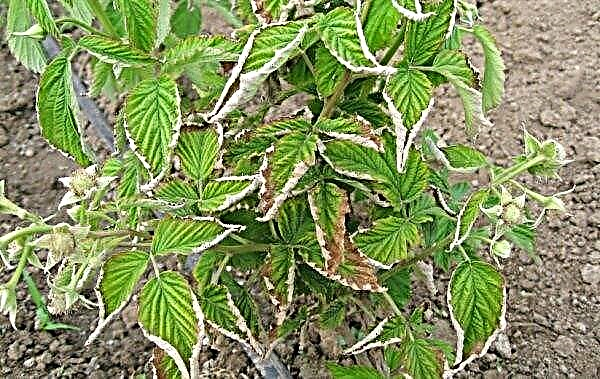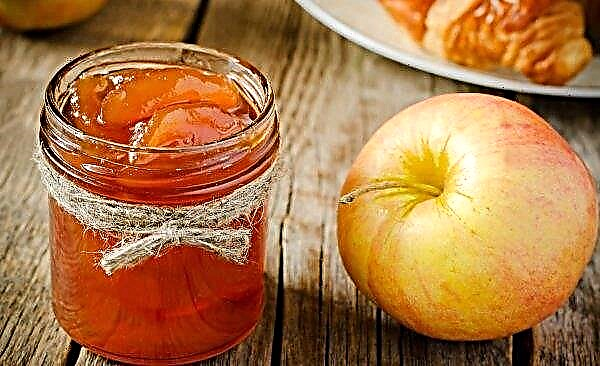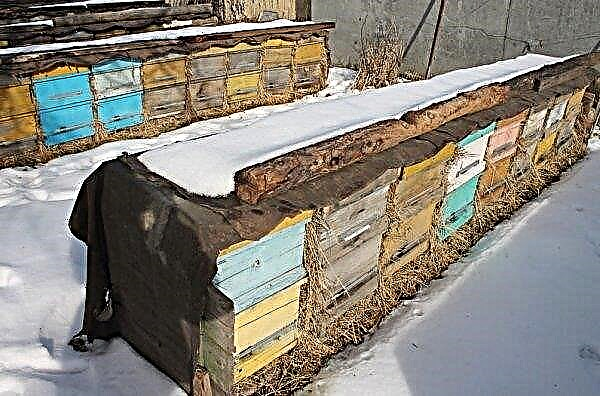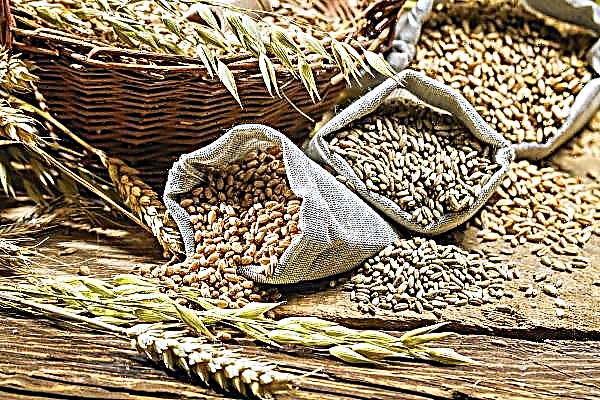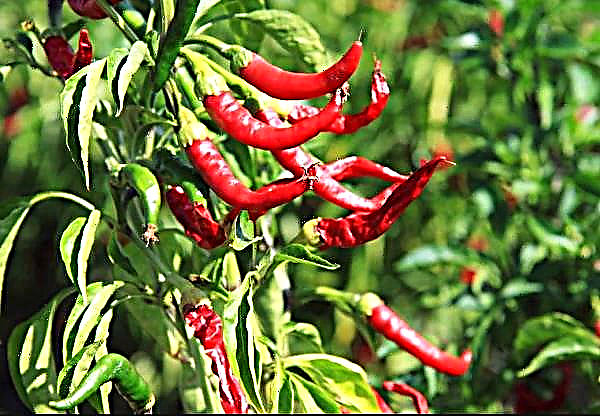Iris is a perennial herb with beautiful, lush flowers. This is especially true for a group of so-called bearded irises, numbering tens of thousands of different varieties. The color of the petals varies from grade to grade, which attracts the attention of gardeners. Although irises are disease resistant, the spring season is the season of risk of rot, bacterial and viral infections. In addition, the sweet aroma of a flower attracts many pests, which can adversely affect its development. Learn how to identify the most common iris diseases and what measures should be taken.
Irises and their diseases
Diseases of the bearded iris are relevant for all climatic conditions, where a flower can naturally grow.
The most common ailments that a flower can hurt can conditionally be divided into:
- bacterial;
- viral;
- fungal.
Did you know? A number of historians have hypothesized that the famous heraldic emblem of the French royal Bourbon dynasty is not a lily at all, but an iris.
A large number of diseases are fungal due to the prevalence of pathogens in the environment. This is due to a wide range of temperatures at which a pathogenic fungus can successfully exist.
Bacterial rot
Wet rot caused by bacteria infects the rhizome of the plant. The disease is caused by microorganisms wintering in the ground. In the early spring, with the disappearance of snow cover, bacteria can infect the iris. Pathogenic organisms take root and multiply rapidly in nitrogen-saturated soil, and during rainy weather, the risk of rot on a flower increases.

In the early stages of the development of the disease, the use of crushed activated carbon can help. However, this will only slow down the development of bacterial rot. To completely get rid of it, you will need to cut off the affected areas and treat the sections with such an antibiotic as Doxycycline.
Fusarium
This disease is another type of rot caused by fungal organisms. Fusarium is dangerous because it can occur at any relatively warm season: the fungus Fusarium oxysporum, which causes rot, can survive at temperatures from + 2 ° C to + 32 ° C. The greatest risk of this disease appearing on the iris occurs during dampness in the temperature range +12 ... + 17 ° С.
The main sign of fusarium is the appearance of odorless rot, the appearance of which is characterized by gray-brown blotches on the surface of the rhizome. In the later stages, rotting areas grow to spots, the color of which first changes to brown, and then to black. This leads to complete drying of the root system.
 To avoid infection of other plants in the garden, it is necessary to remove the diseased flower. Treat the former place of its growth with copper chloride. To prevent the appearance of fusarium in the garden, use individual supplements for each plant in the future.
To avoid infection of other plants in the garden, it is necessary to remove the diseased flower. Treat the former place of its growth with copper chloride. To prevent the appearance of fusarium in the garden, use individual supplements for each plant in the future.
Heterosporosis
Pleaf clotting, or heterosporosis, may occur in late summer in wet weather. This is because the fungus that causes the disease quickly spreads in heat and dampness, especially in alkaline soils with a low phosphate content.
Heterosporiosis significantly affects the appearance of the iris: oblong-shaped spots appear on its leaves, changing the color of the flower from green to light brown. If the plant is not treated in time, its tissues will begin to dry out. With a high probability this will not kill the iris, but will greatly affect its decorative qualities.Important! Buy special plant nutrition only in trusted stores for gardeners. Poor mixes may not only to be useless, but also to cause other ailments in flowers.
 You can get rid of heterosporosis by treating diseased areas with preparations containing copper. It is also worth adding fertilizer with phosphate and calcium nitrate to the soil.
You can get rid of heterosporosis by treating diseased areas with preparations containing copper. It is also worth adding fertilizer with phosphate and calcium nitrate to the soil.
Gray rot stems
Iris is especially vulnerable to the appearance of gray rot of the stem part during its flowering. At low temperatures and dampness, Botrytis cinerea can multiply rapidly and cause rotting in plants. The disease manifests itself in the form of a defeat of the stem, a change in its color to a brown hue. In the later stages of the development of the disease, an iris appears on the iris, reminiscent of gray mold.
There are cases when gardeners themselves become the cause of a disease in a flower: when a large amount of nitrogen-containing fertilizing is applied to the soil, the rate of development of a harmful fungus increases. Effectively treat the plant will be obtained with the help of such drugs as Profit and Kuproskat.
Gray rot rhizomes iris
The root system is affected by gray rot in early spring, when the weather is wet and the air temperature remains low. Under such conditions, the pathogen is extremely active: the fungus Botrytis convolute. The disease does not appear in full immediately: the first subtle, but significant sign can be observed in the spring season, if the iris grows at a slow pace. By mid-summer, the rhizome will be destroyed by dry rot, and the flower fan will quickly die out, which will completely destroy the plant. It will be possible to save the iris using such means as Maxim, Kuproskat and Oksikhom.
The disease does not appear in full immediately: the first subtle, but significant sign can be observed in the spring season, if the iris grows at a slow pace. By mid-summer, the rhizome will be destroyed by dry rot, and the flower fan will quickly die out, which will completely destroy the plant. It will be possible to save the iris using such means as Maxim, Kuproskat and Oksikhom.
Rust
This disease appears due to the fungus Puccinia iridis at an average temperature of +10 ... + 15 ° C. A distinctive feature of iris rust is the coating of leaves with red spores of the fungus. Outwardly, they resemble rusty dust. The plant itself begins to become covered with brown stripes, starting with leaves.
 The fungicidal preparations “Topaz” and “Ordan” are used to treat the affected flower, which are also effective against many other fungi.
The fungicidal preparations “Topaz” and “Ordan” are used to treat the affected flower, which are also effective against many other fungi.
Disease Prevention and Prevention
One of the main conditions for the prevention of most diseases, both fungal and bacterial, is to maintain a neutral pH, pH. This can be done with a special bait, like phosphorus. It is important not to overdo it with fertilizer: the high nitrogen content in the soil often plays a key role in the appearance and reproduction of harmful fungi. At the same time, it is impossible to fertilize the soil with not rotted compost, which includes the remains of plants, as well as fresh manure.
Important! It is easier for organisms that cause ailments in the iris to get inside the flower if it is damaged. In this regard, it is important to maintain the integrity of both rhizomes and leaves, plant flowers, avoiding any injuries.
The initial planting conditions play a significant role: to avoid the fact that the iris will become sick in the future, pre-prepared and drained soil will help, as well as the destruction of dead flower residues and the independent removal of the aged parts of the iris. In addition, regular weeding of weeds will not only preserve the attractive appearance of the garden, but also reduce the risk of transmitting diseases from them, such as rust, to your plants.
In the autumn, do not forget to mulch the planting of flowers, and in the spring, avoid stagnation of water after the snow melts. If you are going to transplant iris, it is highly recommended not to do this during flowering, and the planting site should be warmed up by the sun, deeply dug up and provide a good level of air circulation. As a preventative measure, the soil should be sprayed with antifungal medications with copper, such as Bordeaux fluid. Fungicides provide protection against harmful fungi for up to 20 days.
Did you know? In Christianity, iris is one of the symbols of the Virgin Mary. It denotes its simultaneous purity and sadness.
Pests of irises
The most common flower pests are insects. Most often on plants you can see aphids, which accumulate mainly on young irises. Its large number is due to the fact that the rate of reproduction of these insects is extremely high. It will be possible to exterminate this insect with the help of a solution of emulsion of malathion or phosphamide. If this did not help to achieve the desired effect, it is worth using soda with calcium and soap. Aphids suck out juices from leaves, which leads to their deformation and weakening of the iris as a whole, and also secretes mucus harmful to flowers.
Aphids suck out juices from leaves, which leads to their deformation and weakening of the iris as a whole, and also secretes mucus harmful to flowers.
Extremely small, but also very dangerous for flowers pests - thrips. They reach a size of only 1 mm. A large number of them not only absorbs the juice, damaging the leaves, but also can destroy the rhizome in a short time, which will lead to the death of the plant. Most often, they are observed during the growing season at temperatures from + 20 ° C to + 25 ° C.
Fighting them is quite simple: dig up the soil, as well as get rid of weeds - these insects breed precisely on them. Aphids suck out juices from leaves, which leads to their deformation and weakening of the iris as a whole, and also secretes mucus harmful to flowers.
 Aphids suck out juices from leaves, which leads to their deformation and weakening of the iris as a whole, and also secretes mucus harmful to flowers.
Aphids suck out juices from leaves, which leads to their deformation and weakening of the iris as a whole, and also secretes mucus harmful to flowers.
Brown iris night butterflies are a reason to carry out prophylaxis with the help of the Trichogramma preparation. Scissors often lay eggs on flower leaves, from which caterpillars hatch after which vital activity leads to yellowing of foliage and fragility of the plant trunk. This is due to the fact that the larvae of butterflies feed on the inner part of the stem and fill them with excrement, which causes the weakening of the iris and its decay.

The largest pests are the bear. Such insects are able to dig the ground and gnaw the roots of flowers with powerful jaws. If you do not get rid of them in time, the rhizome and trunk of the iris will be so damaged that the plant will die. To effectively combat the bears, you need to dig the soil and add ammonia to it. The use of baits is also possible: make a mixture of boiled grain with vegetable oil and the preparation “Karbofos”.

Most of the damage caused to the plant occurs in the activity of beetles and larvae. They eat the roots of iris, and adults damage the appearance of irises.
Among pest beetles are especially dangerous:
- european marble horsetail;
- furry deer;
- golden bronze.
 All of them feed on petals and foliage of flowers. Bronze bronze is often confused with the May bug: both representatives belong to the same family. However, the pest has a brighter color with a reflective effect, as well as the ability to fly.
All of them feed on petals and foliage of flowers. Bronze bronze is often confused with the May bug: both representatives belong to the same family. However, the pest has a brighter color with a reflective effect, as well as the ability to fly.
Many beetles feed not only on flowers. So, the European marble horsetail devours needles and poplar leaves, and bronze leaves prefers to eat flowers of berry crops. For this reason, do not plant irises near these plants to avoid damage. You can fight bugs this way: find the habitat of the larvae and dig it up. Often, masonry is located in the rotten wood of old logs, boards, etc., which you need to get rid of. Light traps that lure insects with light are also highly effective.
Light traps that lure insects with light are also highly effective.
In spring and autumn, when the weather is damp, and the temperature does not exceed + 20 ° C, slugs can create problems for the growth of flowers. It is noteworthy that often they damage the plant at night, but in the morning the gardener can be sure of their presence by noticing dried mucus. To destroy slugs, you need to drain the soil and dig it. It is important to get rid of weeds and the remains of dead plants. Iron sulfate should be added to the soil for the complete destruction of slugs.
How to protect from pests
In order not to have to fight and exterminate pests, do not allow their appearance with the help of preventive measures.
Basic prevention includes the following steps:
- digging the soil;
- proper fertilizer and soil enrichment;
- timely watering;
- drying of the soil from thawed snow;
- elimination of weeds.
Video: Iris Care
As in the case of diseases, the maintenance of a neutral pH at the place of iris growth also helps against pests. Since this flower is not suitable for food, it can be safely treated with special toxic chemicals at the beginning of the growing season and in the summer.
Although iris is a plant resistant to ailments, with improper care, it can also become sick. It is enough for the gardener to maintain normal amounts of minerals in the soil, as well as timely weed nearby soil. When performing these simple steps, the plant will delight you with a decorative look and a special iris aroma for a long time. Pay attention to mechanical damage and discoloration of the stem and foliage - these may be signals of incipient diseases from which the flower can be cured, provided that the procedures are timely.

